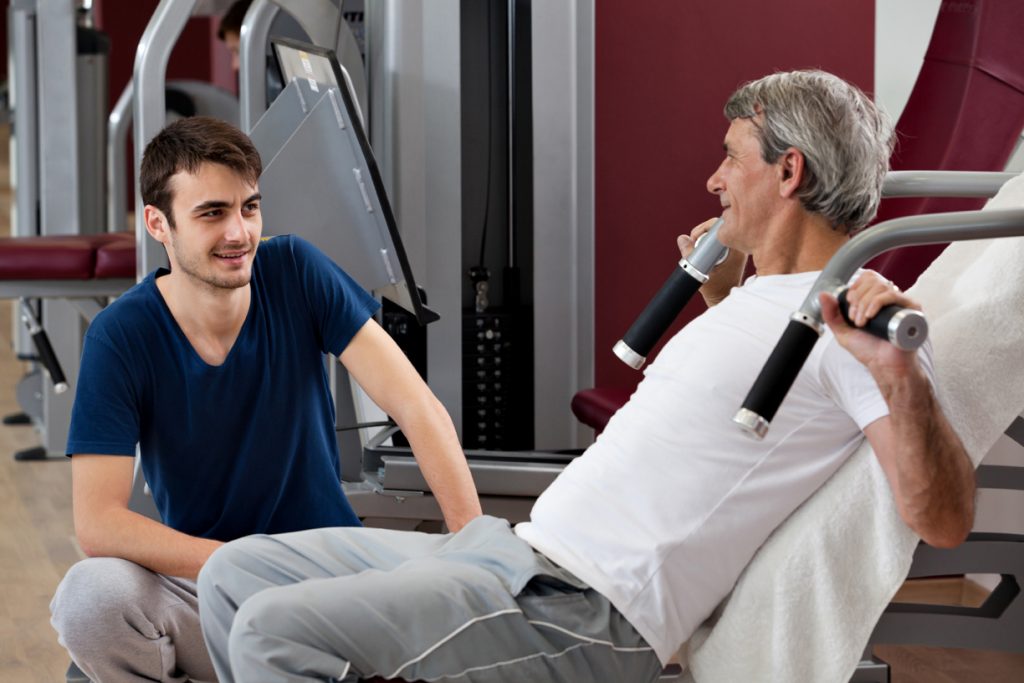In my previous article I made a case for a comprehensive resistance training program as a way to “cut the odds” in our favor as we “grow older and not old”. I also strongly believe in developing a strong cardiovascular system since it is responsible for keeping the life giving oxygen and nutrients moving into the body’s tissues and organs in order to sustain our lives. These two beliefs are driven by my desire to keep my body as strong and adaptable (and flexible) as I can in order to “prevent” challenges of all kinds from entering my experience in the future.
 I would like to examine programming and execution in this article in order to enable and empower you to “take up the challenge” of becoming more than you ever thought possible through a well planned resistance training program that enhances your life through an acquired discipline, focus and commitment to your own health and well being. This process – (and it is a process) – continues throughout our lifetimes and rests on the foundation of a desire to consistently learn new things about ourselves. It is a process of expanding not only our own consciousness, skill and knowledge of our potential health and fitness futures – but also includes our developing ability to maintain such a process over time.
I would like to examine programming and execution in this article in order to enable and empower you to “take up the challenge” of becoming more than you ever thought possible through a well planned resistance training program that enhances your life through an acquired discipline, focus and commitment to your own health and well being. This process – (and it is a process) – continues throughout our lifetimes and rests on the foundation of a desire to consistently learn new things about ourselves. It is a process of expanding not only our own consciousness, skill and knowledge of our potential health and fitness futures – but also includes our developing ability to maintain such a process over time.
TRACKING
I find the key to my success over the past 55 years has been my desire and commitment to retain my program of running and resistance training by tracking all of my workouts – both running and weightlifting – allowing me to know “where I am” at any point in time. These records keep me up to date on the factors influencing my growth and reflect my effort to attain my goals of improving strength. power, endurance, speed, quickness, flexibility and balance.
The reality is that today “tracking devices” are available through technological advances and now can serve us in ways that I never dreamed possible before. I still record my results in logs and journals and appreciate the way in which this form of tracking has enabled and inspired me to keep going and improve my results. The gym where I train is filled with people “wandering” through their time there and never really getting focused while staring at their electronic devices or “smart” phones. NO ONE ever is tracking their work and consequently they will never know when – or how – to improve.
RESISTANCE TRAINING
Resistance training is the progressive stimulation of muscle fibers in order to create a more adaptable and powerful muscle. The “loads” we place on particular muscle “groups” are in alignment with the capability, experience and knowledge of the individual executing the program. There are type I and type II fibers. Each type responds differently to the multiple “stimuli” applied.
Type I fibers handle loads “over time” and respond well to longer periods of stress thereby classifying them more as “endurance” fibers. Type II fibers do not become engaged until the load reaches a high enough level where they get “recruited” to assist in handling the applied load. They are power fibers and help with explosive movements such as sprinting from danger. They normally are not required in the day to day activities most people engage in and only when we need them will they enter the equation. If they never get trained to respond however, the odds of being able to engage them when needed becomes remote.
THE PYRAMID
BASE SET (8-12 reps): This set warms the muscle and allows it to perform under a minimal load preparing it for more work in subsequent sets. A set is a prescribed number of repetitions that puts the muscle through a complete range of motion and allows the muscle to “respond” to the load. This stimulus enhances the neuromuscular system to become more capable and ready to help our bodies move effectively throughout the day or when doing other activities requiring a response such as cycling, swimming or hiking.
STRENGTH SET (4-8 reps): This set increases the load and allows for a greater stimulus and response to the activity of moving a “heavier load” through a full range of motion. This set is a “building set” since its intention is to take the muscle to “fatigue” allowing for growth during recovery and down time. One can induce additional growth in this phase by adding sets and continuing the process – depending on your experience and readiness to train in this more advanced manner.
BASE SET (8-12 reps): The final part of the pyramid is to return to a lighter load – not necessarily the original load – and allow the muscle to “work through” the waste that accumulates in the fibers as a result of the prior stimulation.
SETS: Sets are the “pieces” – the individual components – to the puzzle of resistance training. “Putting it all together” in a cohesive program is very important in determining your success. Generally, it is advisable to seek professional guidance when assembling a resistance training program since determining proper training technique, loads and the types of exercises can become quite daunting if you are inexperienced and lack the proper knowledge to do it yourself.

I think of this issue in the following manner: If I am attempting an activity such as snow skiing that I have limited or no experience or skill in doing, I will hire an instructor to teach me the basics and allow me to LEARN how be safe while I learn and begin to enjoy this new activity SAFELY.
PROGRAMMING EXAMPLES
(Include free weights, machine assisted and body weight exercises in planning)
Chest: Push ups (regular and modified), bench press (free weights), or machine press.
Shoulders: Overhead press (dumbbells), lateral raise (machine), rubber tubing with handles.
Back: Lat pull (cable), seated row – tubing, machine, wall press (body).
Arms: Curl (free weights), tubing, machine curl.
Abdominals: Basic crunch (knees bent, upper body life), resistance balls (destabilized crunch), wall crunches with back flat on wall.
Legs: Squats (wall) and lunges (static or moving), leg press (machine) calf extension (stairs and machine).
IN SUMMARY
Resistance training is the “pay check” and cardio is the “bonus”. My former fitness manager said these words to me over twenty years ago and I cannot disagree with him today. You will not get an argument from me on the benefits and power of a well planned resistance training program – especially after the age of 40! The idea that we can maintain our muscular strength and endurance over time WITHOUT training is ludicrous.
Every day that passes without proper stimulation of our major muscle groups is a day that we will never recover. The outcome could become catastrophic if we break a hip or suffer some other major injury that could eventually end our lives. I schedule my own resistance training sessions on Monday and Thursday so as to maximize my training and recovery times. Each program is varied by the number of sets I do, the resistance I engage and the time I take to execute the program. Each session is designed with this thought in mind: MAINTAIN my current lean muscle mass and strength for the years to come.
Your programming efforts are waiting for your decision to begin this new phase of your life and it is MOST definitely a “life affirming” decision. Take the time today to evaluate your needs and make the decision to begin TODAY! If you need help to get started – as I would with my skiing example – then get it! Don’t be afraid to learn new skills that could possibly save your life “down the road” because you – and your body – will be grateful you took a positive step that will NEVER let you down. I embrace this message myself everyday – and KNOW you will too! Travel well.
Reprinted with permission from Nicholas Prukop.
Nicholas Prukop is an ACE Certified Personal Trainer & a Health Coach, a fitness professional with over 25 years of experience whose passion for health and fitness comes from his boyhood in Hawaii where he grew up a swimmer on Maui. He found his calling in writing his first book “Healthy Aging & You: Your Journey to Becoming Happy, Healthy & Fit” and since then he has dedicated himself to empowering, inspiring and enabling people of all ages to reach for the best that is within them and become who they are meant to be – happy, healthy and fit – and be a part of a world where each person can contribute their own unique gifts to life.
If you need help in designing a fitness plan, you can contact Nicholas Prukop via email at runningnick@sbcglobal.net or read his inspiring book Healthy Aging & YOU.

